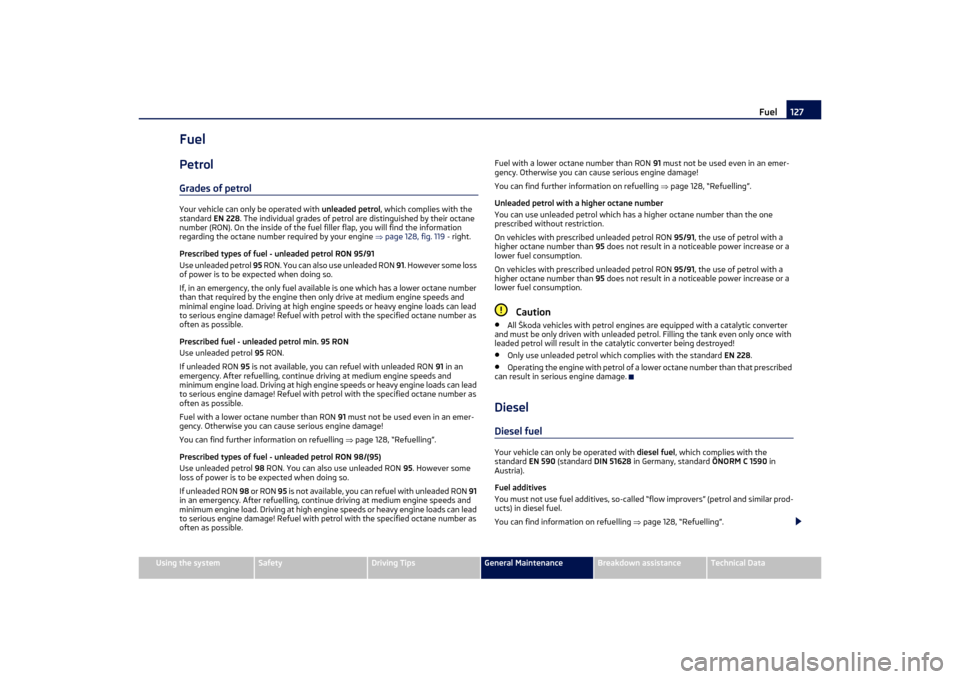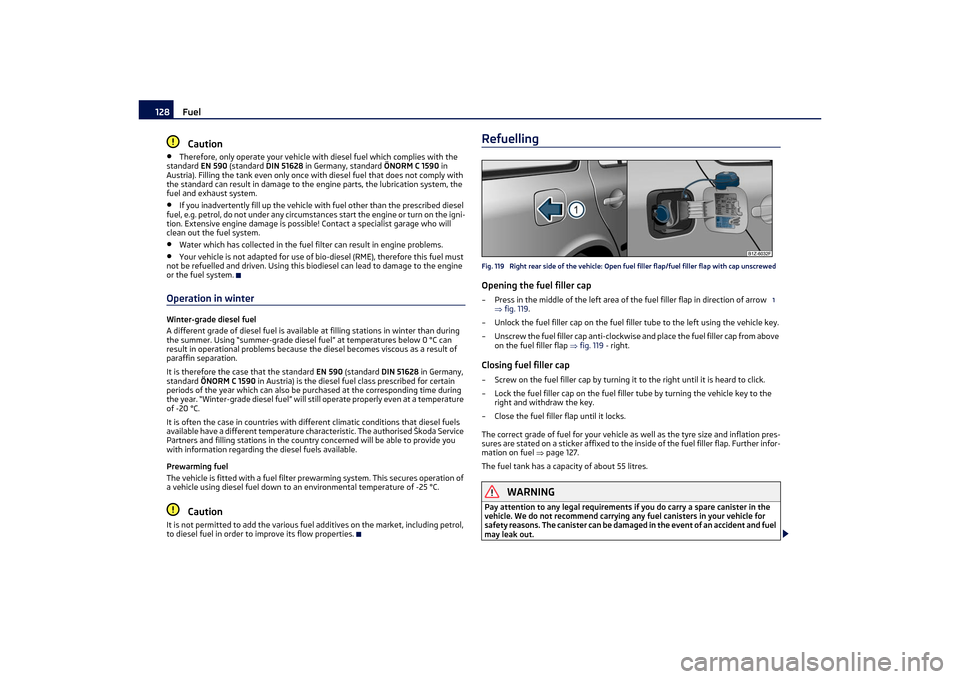fuel additives SKODA OCTAVIA TOUR 2011 2.G / (1Z) Owner's Manual
[x] Cancel search | Manufacturer: SKODA, Model Year: 2011, Model line: OCTAVIA TOUR, Model: SKODA OCTAVIA TOUR 2011 2.G / (1Z)Pages: 183, PDF Size: 11.13 MB
Page 128 of 183

Fuel127
Using the system
Safety
Driving Tips
General Maintenance
Breakdown assistance
Technical Data
FuelPetrolGrades of petrolYour vehicle can only be operated with unleaded petrol, which complies with the
standard EN 228. The individual grades of petrol are distinguished by their octane
number (RON). On the inside of the fuel filler flap, you will find the information
regarding the octane number required by your engine page 128, fig. 119 - right.
Prescribed types of fuel - unleaded petrol RON 95/91
Use unleaded petrol 95 RON. You can also use unleaded RON 91. However some loss
of power is to be expected when doing so.
If, in an emergency, the only fuel available is one which has a lower octane number
than that required by the engine then only drive at medium engine speeds and
minimal engine load. Driving at high engine speeds or heavy engine loads can lead
to serious engine damage! Refuel with petrol with the specified octane number as
often as possible.
Prescribed fuel - unleaded petrol min. 95 RON
Use unleaded petrol 95 RON.
If unleaded RON 95 is not available, you can refuel with unleaded RON 91 in an
emergency. After refuelling, continue driving at medium engine speeds and
minimum engine load. Driving at high engi ne speeds or heavy engine loads can lead
to serious engine damage! Refuel with petrol with the specified octane number as
often as possible.
Fuel with a lower octane number than RON 91 must not be used even in an emer-
gency. Otherwise you can cause serious engine damage!
You can find further information on refuelling page 128, “Refuelling”.
Prescribed types of fuel - unleaded petrol RON 98/(95)
Use unleaded petrol 98 RON. You can also use unleaded RON 95. However some
loss of power is to be expected when doing so.
If unleaded RON 98 or RON 95 is not available, you can refuel with unleaded RON 91
in an emergency. After refuelling, continue driving at medium engine speeds and
minimum engine load. Driving at high engi ne speeds or heavy engine loads can lead
to serious engine damage! Refuel with petrol with the specified octane number as
often as possible. Fuel with a lower octane number than RON
91 must not be used even in an emer-
gency. Otherwise you can cause serious engine damage!
You can find further information on refuelling page 128, “Refuelling”.
Unleaded petrol with a higher octane number
You can use unleaded petrol which has a higher octane number than the one
prescribed without restriction.
On vehicles with prescrib ed unleaded petrol RON 95/91, the use of petrol with a
higher octane number than 95 does not result in a noticeable power increase or a
lower fuel consumption.
On vehicles with prescrib ed unleaded petrol RON 95/91, the use of petrol with a
higher octane number than 95 does not result in a noticeable power increase or a
lower fuel consumption.
Caution
•
All Škoda vehicles with petrol engines are equipped with a catalytic converter
and must be only driven with unleaded petr ol. Filling the tank even only once with
leaded petrol will result in the catalytic converter being destroyed!
•
Only use unleaded petrol which complies with the standard EN 228.
•
Operating the engine with petrol of a lo wer octane number than that prescribed
can result in serious engine damage.
DieselDiesel fuelYour vehicle can only be operated with diesel fuel, which complies with the
standard EN 590 (standard DIN 51628 in Germany, standard ÖNORM C 1590 in
Austria).
Fuel additives
You must not use fuel additives, so-called “flow improvers” (petrol and similar prod-
ucts) in diesel fuel.
You can find information on refuelling page 128, “Refuelling”.
s2lk.2.book Page 127 Monday, April 18, 2011 7:41 AM
Page 129 of 183

Fuel
128Caution
•
Therefore, only operate your vehicle with diesel fuel which complies with the
standard EN 590 (standard DIN 51628 in Germany, standard ÖNORM C 1590 in
Austria). Filling the tank even only once wi th diesel fuel that does not comply with
the standard can result in damage to the engine parts, the lubrication system, the
fuel and exhaust system.
•
If you inadvertently fill up the vehicle with fuel other than the prescribed diesel
fuel, e.g. petrol, do not under any circumstan ces start the engine or turn on the igni-
tion. Extensive engine damage is possible! Contact a specialist garage who will
clean out the fuel system.
•
Water which has collected in the fuel filter can result in engine problems.
•
Your vehicle is not adapted for use of bio-diesel (RME), therefore this fuel must
not be refuelled and driven. Using this biodiesel can lead to damage to the engine
or the fuel system.
Operation in winterWinter-grade diesel fuel
A different grade of diesel fuel is available at filling stations in winter than during
the summer. Using “summer-grade diesel fuel” at temperatures below 0 °C can
result in operational problems because th e diesel becomes viscous as a result of
paraffin separation.
It is therefore the case that the standard EN 590 (standard DIN 51628 in Germany,
standard ÖNORM C 1590 in Austria) is the diesel fuel class prescribed for certain
periods of the year which can also be purchased at the corresponding time during
the year. “Winter-grade diesel fuel” will still operate properly even at a temperature
of -20 °C.
It is often the case in countries with diff erent climatic conditions that diesel fuels
available have a different te mperature characteristic. Th e authorised Škoda Service
Partners and filling stations in the country concerned will be able to provide you
with information regarding the diesel fuels available.
Prewarming fuel
The vehicle is fitted with a fuel filter pr ewarming system. This secures operation of
a vehicle using diesel fuel down to an environmental temperature of -25 °C.
Caution
It is not permitted to add the various fuel additives on the market, including petrol,
to diesel fuel in order to improve its flow properties.
RefuellingFig. 119 Right rear side of the vehicle: Open fuel filler flap/fuel filler flap with cap unscrewedOpening the fuel filler cap– Press in the middle of the left area of the fuel filler flap in direction of arrow
fig. 119 .
– Unlock the fuel filler cap on the fuel filler tube to the left using the vehicle key.
– Unscrew the fuel filler cap anti-clockwise and place the fuel filler cap from above on the fuel filler flap fig. 119 - right.Closing fuel filler cap– Screw on the fuel filler cap by turning it to the right until it is heard to click.
– Lock the fuel filler cap on the fuel filler tube by turning the vehicle key to the right and withdraw the key.
– Close the fuel filler flap until it locks.
The correct grade of fuel for your vehicle as well as the tyre size and inflation pres-
sures are stated on a sticker affixed to the in side of the fuel filler flap. Further infor-
mation on fuel page 127.
The fuel tank has a capacity of about 55 litres.
WARNING
Pay attention to any legal requirements if you do carry a spare canister in the
vehicle. We do not recommend carrying any fuel canisters in your vehicle for
safety reasons. The canister can be damaged in the event of an accident and fuel
may leak out.
1
s2lk.2.book Page 128 Monday, April 18, 2011 7:41 AM